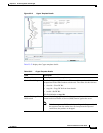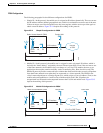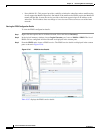
25-92
Cisco Prime Network 4.0 User Guide
OL-29343-01
Chapter 25 Monitoring Mobile Technologies
LTE Networks
Configuration Commands for ePDG
The ePDG commands allow you to configure ePDG services in your network. Please note that these
commands are available only for Cisco ASR 5000 Mobile devices.
These commands can be launched from the logical inventory by choosing the
Context > Commands > Configuration or Context > Commands > Show.
Before executing any commands, you can preview them and view the results. If desired, you can also
schedule the commands.
The table below lists the ePDG commands. Additional commands may be available for your devices.
New commands are often provided in Prime Network Device Packages, which can be downloaded from
the Prime Network software download site. For more information on how to download and install DPs
and enable new commands, see the information on “Adding Additional Device (VNE) support” in the
Cisco Prime Network 4.0 Administrator Guide.
Note You might be prompted to enter your device access credentials while executing a command. Once you
have entered them, these credentials will be used for every subsequent execution of a command in the
same GUI client session. If you want to change the credentials, click Edit Credentials. The Edit
Credentials button will not be available for SNMP commands or if the command is scheduled for a later
time.
Table 25-56 lists the ePDG configuration commands.
Monitoring Packet Data Serving Node (PDSN)
Packet Data Serving Node, or PDSN, is a component of the Code Division Multiple Access (CDMA)
2000 mobile network. It acts as a connection point between the Radio Access Network (RAN) and IP
Network. PDSN also manages PPP sessions between the mobile provider’s core IP network and the
mobile node.
In other words, it provides access to the Internet, intranets, and applications servers for mobile stations
that utilize a CDMA2000 RAN. Acting as an access gateway, PDSN provides simple IP and mobile IP
access, foreign agent support, and packet transport for virtual private networking. It acts as a client for
Authentication, Authorization, and Accounting (AAA) servers and provides mobile stations with a
gateway to the IP network.
Table 25-56 ePDG Configuration Commands
Command Navigation Description
Create ePDG
Service
Right-click context > Commands >
Configuration >
Use this command to create a new ePDG
service.
Modify ePDG
Service
Expand EPDG Node > right-click EPDG
service > Commands > Configuration
Use this command to modify the
configuration details for an ePDG service.
Delete ePDG
Service
Expand EPDG Node > right-click EPDG
service > Commands > Configuration
Use this command to delete an ePDG
service.
Show ePDG
Service
Expand EPDG Node > right-click EPDG
service > Commands > Show
Use this command to view and confirm the
configuration details of an ePDG Service.


















